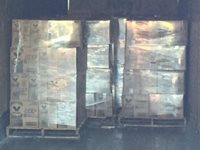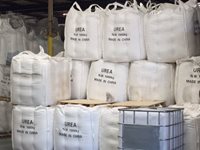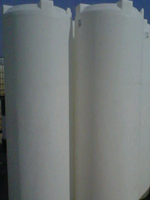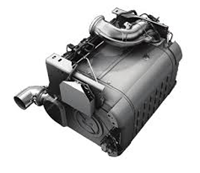 Since switching to a CNG-powered Freightliner Cascadia over a year and a half ago, I would be lying if I said I actually missed having to fill up two fluids at the fuel island when the time came to “fill ‘er up”. In a little bit of irony, my DEF-less truck was tasked this week with hauling a return load of DEF fluid for the manufacturer. A lot of folks out there have confused this liquid that aids in emission control for things such as pig urine, cow urine, and all sorts of other things. After my $0.50 tour of the manufacturing facility, I am here to now put to rest some of the DEF fluid wise-tales.
Since switching to a CNG-powered Freightliner Cascadia over a year and a half ago, I would be lying if I said I actually missed having to fill up two fluids at the fuel island when the time came to “fill ‘er up”. In a little bit of irony, my DEF-less truck was tasked this week with hauling a return load of DEF fluid for the manufacturer. A lot of folks out there have confused this liquid that aids in emission control for things such as pig urine, cow urine, and all sorts of other things. After my $0.50 tour of the manufacturing facility, I am here to now put to rest some of the DEF fluid wise-tales.
 When pulling into the delivery facility, I had to first examine if I was in the right place or not, as I did not see a pig or cattle farm within the industrial complex. Instead, I found myself peering into a warehouse full of giant plastic sacks labeled “UREA” and several large liquid storage tanks. I had always known that contrary to the belief of some, DEF was liquid urea, so I figured I had to be in the right place. After backing in to unload, I struck up a conversation with the manager and received a tour that clarified for me the simple process of producing DEF fluid for use in diesel exhaust after-treatment systems.
When pulling into the delivery facility, I had to first examine if I was in the right place or not, as I did not see a pig or cattle farm within the industrial complex. Instead, I found myself peering into a warehouse full of giant plastic sacks labeled “UREA” and several large liquid storage tanks. I had always known that contrary to the belief of some, DEF was liquid urea, so I figured I had to be in the right place. After backing in to unload, I struck up a conversation with the manager and received a tour that clarified for me the simple process of producing DEF fluid for use in diesel exhaust after-treatment systems.
 It all starts with a synthesized granule form of urea. This is where most of the “urine” rumors come from, as humans excrete an average of 30 grams of urea daily in the form of urine and sweat, to aid in nitrogen excretion. Many mammals are capable of naturally producing urine as well, which is where the pigs and cows come into play. The synthetic, non-urine form,
It all starts with a synthesized granule form of urea. This is where most of the “urine” rumors come from, as humans excrete an average of 30 grams of urea daily in the form of urine and sweat, to aid in nitrogen excretion. Many mammals are capable of naturally producing urine as well, which is where the pigs and cows come into play. The synthetic, non-urine form,  used for making diesel DEF fluid is actually created from ammonia and carbon dioxide. It is also very widely used in the making of fertilizers and its appearance resembles something between fake snow and raw plastic pellets.
used for making diesel DEF fluid is actually created from ammonia and carbon dioxide. It is also very widely used in the making of fertilizers and its appearance resembles something between fake snow and raw plastic pellets.
 It is emptied from the sacks and mixed with ultra-pure water that undergoes an extensive in-house filtration prior to having the urea pellets added to it. It is then mixed, filtered and stored until it is pumped into one of the three final product lines that they ship out – bulk plastic tanks, tanker trucks, or retail jugs. The utmost attention is paid towards the purity levels of the finished product. The load I was actually returning was actually only returned because of an appearance issue. A harmless film was detected settling on the bottom of the jugs in that particular batch, due to a change in climate, but would not have affected performance. This small detail was enough for them to recall that batch and install a new type of filter in between the storage tanks and the final packaging to eliminate this appearance issue as an improvement to their quality control process.
It is emptied from the sacks and mixed with ultra-pure water that undergoes an extensive in-house filtration prior to having the urea pellets added to it. It is then mixed, filtered and stored until it is pumped into one of the three final product lines that they ship out – bulk plastic tanks, tanker trucks, or retail jugs. The utmost attention is paid towards the purity levels of the finished product. The load I was actually returning was actually only returned because of an appearance issue. A harmless film was detected settling on the bottom of the jugs in that particular batch, due to a change in climate, but would not have affected performance. This small detail was enough for them to recall that batch and install a new type of filter in between the storage tanks and the final packaging to eliminate this appearance issue as an improvement to their quality control process.
 As a much-needed tool in meeting stringent emissions guidelines for diesel engines, I was surprised that the manufacturing process was as simple as it was explained to me in my tour of the plant. I was also happy to see that the rumors or urine being squirted into the after-treatment systems in trucks was debunked. I will admit that before I knew synthetic urea was used, I did sort of “weird out” at the DEF pump and made sure I used to wear nitrile gloves before pumping it from the dispenser. That white, scaly, build-up on the pump was never a reassuring sight in fighting the urine myth either!
As a much-needed tool in meeting stringent emissions guidelines for diesel engines, I was surprised that the manufacturing process was as simple as it was explained to me in my tour of the plant. I was also happy to see that the rumors or urine being squirted into the after-treatment systems in trucks was debunked. I will admit that before I knew synthetic urea was used, I did sort of “weird out” at the DEF pump and made sure I used to wear nitrile gloves before pumping it from the dispenser. That white, scaly, build-up on the pump was never a reassuring sight in fighting the urine myth either!